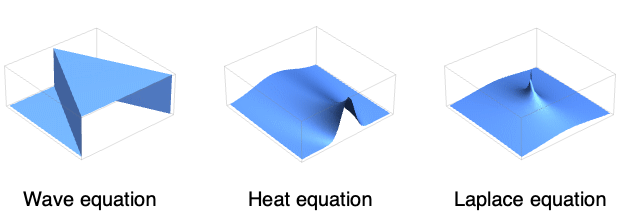GreenFunction
GreenFunction[{ℒ[u[x]],ℬ[u[x]]},u,{x,xmin,xmax},y]
gives a Green's function for the linear differential operator ℒ with boundary conditions ℬ in the range xmin to xmax.
GreenFunction[{ℒ[u[x1,x2,…]],ℬ[u[x1,x2,…]]},u,{x1,x2,…}∈Ω,{y1,y2,…}]
gives a Green's function for the linear partial differential operator ℒ over the region Ω.
GreenFunction[{ℒ[u[x,t]],ℬ[u[x,t]]},u,{x,xmin,xmax},t,{y,τ}]
gives a Green's function for the linear time-dependent operator ℒ in the range xmin to xmax.
GreenFunction[{ℒ[u[x1,…,t]],ℬ[u[x1,…,t]]},u,{x1,…}∈Ω,t,{y1,…,τ}]
gives a Green's function for the linear time-dependent operator ℒ over the region Ω.
Details and Options

- GreenFunction represents the response of a system to an impulsive DiracDelta driving function.
- GreenFunction for a differential operator
 is defined to be a solution
is defined to be a solution  of
of ![L(G(x;y))=TemplateBox[{{x, -, y}}, DiracDeltaSeq] L(G(x;y))=TemplateBox[{{x, -, y}}, DiracDeltaSeq]](Files/GreenFunction.en/3.png) that satisfies the given homogeneous boundary conditions
that satisfies the given homogeneous boundary conditions  .
. - A particular solution of
 with homogeneous boundary conditions
with homogeneous boundary conditions  can be obtained by performing a convolution integral
can be obtained by performing a convolution integral  .
. - GreenFunction for a time-dependent differential operator
 is defined to be a solution
is defined to be a solution  of
of ![L(G(x,t;y,tau))=TemplateBox[{{x, -, y}}, DiracDeltaSeq]TemplateBox[{{t, -, tau}}, DiracDeltaSeq] L(G(x,t;y,tau))=TemplateBox[{{x, -, y}}, DiracDeltaSeq]TemplateBox[{{t, -, tau}}, DiracDeltaSeq]](Files/GreenFunction.en/10.png) that satisfies the given homogeneous boundary conditions
that satisfies the given homogeneous boundary conditions  .
. - A particular solution of
 with homogeneous boundary conditions
with homogeneous boundary conditions  can be obtained by performing a convolution integral
can be obtained by performing a convolution integral  .
. - The Green's functions for classical PDEs have characteristic geometrical properties:
 is given as an expression in
is given as an expression in  and
and  if the dependent variable is of the form
if the dependent variable is of the form  , and as a pure function with formal parameters
, and as a pure function with formal parameters  and
and  if the dependent variable is of the form
if the dependent variable is of the form  instead of
instead of  . »
. »- The region Ω can be anything for which RegionQ[Ω] is True.
- All the necessary initial and boundary conditions for ODEs must be specified in
 .
. - Boundary conditions for PDEs must be specified using DirichletCondition or NeumannValue in
 .
. - Assumptions on parameters may be specified using the Assumptions option.

Examples
open allclose allBasic Examples (2)
Scope (22)
Basic Uses (2)
Compute the Green's function for an ordinary differential operator:
Obtain a pure function in the result by using u instead of u[x] in the second argument:
Compute the Green's function for a partial differential operator:
Obtain a pure function in the result by using u instead of u[x,t] in the second argument:
Ordinary Differential Equations (4)
Wave Equation (4)
Green's function for the wave operator on the real line:
Green's function for the wave operator with a Dirichlet condition on a half-line:
Green's function for the wave operator with a Neumann condition on a half-line:
Green's function for the wave operator with a Dirichlet condition on an interval:
Heat Equation (5)
Green's function for the heat operator on the real line:
Green's function for the heat operator with a Dirichlet condition on a half-line:
Green's function for the heat operator with a Dirichlet condition on an interval:
Green's function for the heat operator with a Neumann condition on an interval:
Laplace Equation (4)
Options (1)
Assumptions (1)
Specify Assumptions on parameters in GreenFunction:
Applications (9)
Ordinary Differential Equations (4)
Solve an initial value problem for an inhomogeneous differential equation using GreenFunction:
Perform a convolution of the Green's function with the forcing function:
Compare with the result given by DSolveValue:
Solve a Dirichlet problem for an inhomogeneous differential equation using GreenFunction:
Perform a convolution of the Green's function with the forcing function:
Compare with the result given by DSolveValue:
Solve a Neumann problem for an inhomogeneous differential equation using GreenFunction:
Perform a convolution of the Green's function with the forcing function:
Compare with the result given by DSolveValue:
Solve a Robin problem for an inhomogeneous differential equation using GreenFunction:
Perform a convolution of the Green's function with the forcing function:
Compare with the result given by DSolveValue:
Partial Differential Equations (2)
Solve the inhomogeneous wave equation using GreenFunction:
Define the inhomogeneous term:
Solve the inhomogeneous equation using ![]() :
:
Compare with the solution given by DSolveValue:
Solve an initial value problem for the heat equation using GreenFunction:
Solve the initial value problem using ![]() :
:
Compare with the solution given by DSolveValue:
Physics and Engineering (3)
Compute the current i[t] in a circuit with a voltage source v[t] that is connected to a resistor R and an inductor L. The operator for this circuit is given by:

Find the current for a given voltage source:
Compute the displacement u[x] for a string of length p and tension T that is fixed at the two ends and is subjected to a force per unit length of f[x]. The operator for the displacement is given by:

Find the displacement for a given force:
The impulse response of a continuous linear time-invariant system can be found by using the Green's function for the system with homogeneous initial conditions. Compute the impulse response for the system defined by:
Green's function for the system with homogeneous initial conditions:
Properties & Relations (2)
Compute a Green's function for a differential equation:
Obtain the same result using DSolve:
GreenFunction is related to OutputResponse and TransferFunctionModel:
Text
Wolfram Research (2016), GreenFunction, Wolfram Language function, https://reference.wolfram.com/language/ref/GreenFunction.html.
CMS
Wolfram Language. 2016. "GreenFunction." Wolfram Language & System Documentation Center. Wolfram Research. https://reference.wolfram.com/language/ref/GreenFunction.html.
APA
Wolfram Language. (2016). GreenFunction. Wolfram Language & System Documentation Center. Retrieved from https://reference.wolfram.com/language/ref/GreenFunction.html